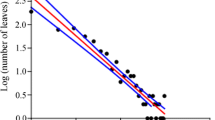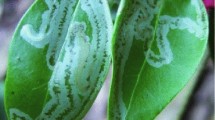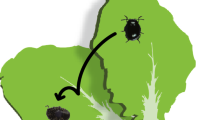Summary
At Sand Lake, Leon County, Florida, mines of Stilbosis quadricustatella, a leaf-mining moth, occur on sand live oak trees (Quercus geminata) over a broad range of densities. Some trees have fewer than 2% of their leaves mined (lightly infested), others up to 70% (heavily infested). Similar levels of infestation are maintained on the same trees year after year. There are no significant negative correlations of miner density per tree with any mortality factor that might explain miner preferences for certain trees. Nor is there a positive correlation with host leaf quality as measured by foliar nitrogen or by total or individual amino acid concentrations of host leaves. Egg-transfer experiments showed that larvae from eggs transferred to lightly infested trees were more likely to be killed by leaf abscission than were those that were transferred to and developed on heavily infested trees. This is the first demonstration that variation in rates of leaf abscission could be an important cause of the observed distribution pattern of sessile insects between conspecific host plants.
Similar content being viewed by others
References
Auerbach M, Simberloff D (1989) Oviposition site preference and larval mortality in a leaf-mining moth. Ecol Entomol 14:131–140
Brodbeck BV, Mizell RF, French WJ, Andersen PC, Aldrich JH (1990) Amino acids as determinants of host preference for the xylem feeding leafhopper, Homalodisca coagulata (Homoptera: Cicadellidae). Oecologia 83:338–345
Crawley MJ (1983) Herbivory. The Dynamics of Animal-Plant Interactions. Blackwell, Oxford
Faeth SH (1990) Aggregation of a leaf miner, Cameraria sp. nov. (Davis): consequences and causes. J Anim Ecol 59:569–586
Faeth SH, Connor EF, Simberloff D (1981) Early leaf abscission: a neglected source of mortality for folivores. Am Nat 117:409–415
Fleiss JL (1981) Statistical Methods for Rates and Proportions, second edition. Wiley, New York
Furuta K (1990) Regulation of population density in the camphor leaf miner. Jpn J Appl Entomol Zool 14:64–70
Green TR, Ryan CA (1973) Wound-induced proteinase inhibitor in tomato leaves: a possible defense mechanism against insects. Science 175:776–777
Hill MG (1980) Susceptibility of Scaevola taccada (Gaertn.) Roxb. bushes to attack by the coccid Icerya seychellarum Westwood: the effects of leaf loss. Ecol Entomol 5:345–352
McFarland D, Ryan CA (1974) Proteinase inhibitor-inducing factor in plant leaves: a phylogenetic survey. Plant Physiol 54:706–708
Mopper S, Feath SH, Boecklen WJ, Simberloff D (1984) Hostspecific variation in leaf miner population dynamics: effects on density, natural enemies and behavior of Stilbosis quadricustatella (Lepidoptera: Cosmopterigidae). Ecol Entomol 9:169–177
Peña-Cortes H, Sanchez-Serrano J, Rocha Sosa M, Willmitzer L (1988) Systemic induction of proteinase-inhibitor-II gene expression in potato plants by wounding. Planta 174:84–89
Potter DA (1985) Population regulation of the native holly leaf miner, Phytomyza ilicicola Loew (Diptera: Agromyzidae), on American holly. Oecologia 66:499–505
Pritchard IM, James R (1984) Leaf fall as a source of leaf miner mortality. Oecologia 64:140–141
Simberloff DS, Stiling PD (1987) Larval dispersion and survivorship in a leafmining moth. Ecology 68:1647–1657
Stiling P, Simberloff D (1989) Leaf abscission: induced defense against pests or response to damage? Oikos 55:43–49
Stiling PD, Simberloff D, Anderson LC (1987) Non-random distribution patterns of leaf miners on oak trees. Oecologia 73:116–119
Strong DR, Lawton JH, Southwood R (1984) Insects on Plants: Community Patterns and Mechanisms. Blackwell, Oxford
Sugimoto T (1980) Models of spatial pattern of egg population of Ranunculus leaf mining fly, Phytomyza ranunculi (Diptera: Agromyzidae), in host leaves. Res Pop Ecol (Kyoto) 22:13–32
Williams AG, Whitham TG (1986) Premature leaf abscission: an induced plant defense agaist gall aphids. Ecology 67:1619–1627
Zwoske G, Majusal DJ, Ryan CA (1980) The direction and rate of transport of the proteinsse inhibitor inducing factor out of wounded tomato leaves (abstract). Plant Physiol 65; [Suppl] 150
Author information
Authors and Affiliations
Rights and permissions
About this article
Cite this article
Stiling, P., Simberloff, D. & Brodbeck, B.V. Variation in rates of leaf abscission between plants may affect the distribution patterns of sessile insects. Oecologia 88, 367–370 (1991). https://doi.org/10.1007/BF00317580
Received:
Accepted:
Issue Date:
DOI: https://doi.org/10.1007/BF00317580




